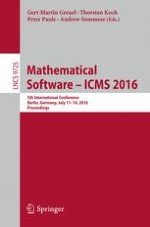This book constitutes the proceedings of the 5th International Conference on Mathematical Software, ICMS 2015, held in Berlin, Germany, in July 2016.
The 68 papers included in this volume were carefully reviewed and selected from numerous submissions. The papers are organized in topical sections named: univalent foundations and proof assistants; software for mathematical reasoning and applications; algebraic and toric geometry; algebraic geometry in applications; software of polynomial systems; software for numerically solving polynomial systems; high-precision arithmetic, effective analysis, and special functions; mathematical optimization; interactive operation to scientific artwork and mathematical reasoning; information services for mathematics: software, services, models, and data; semDML: towards a semantic layer of a world digital mathematical library; miscellanea.
